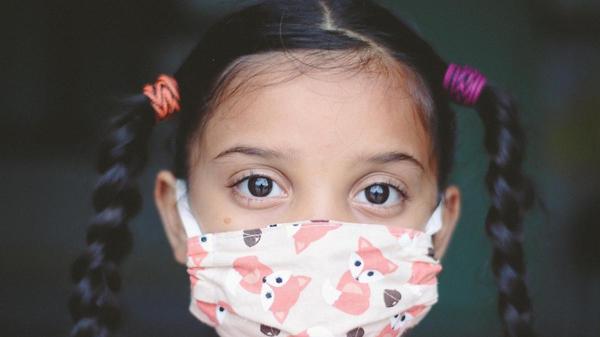17
02/2023
The first studies on this subject are beginning to see the light. An investigation carried out by the Education Endowment Foundation (EEF) in 58 schools throughout England determined that students up to the age of five have needed support in returning to school after confinement, especially in issues related to communication and language.
In fact, the vast majority of schools surveyed (96%) stated that they were "very" or "quite" concerned about this skill, even ahead (91%) of those who expressed concern about personal development, children's emotional and social Something that has led two-fifths of the country's primary schools to apply for an “early language intervention” program funded by the Department of Education.
But, in what way can the use of masks affect the development of speech, language and the communication of the little ones? Speech therapists remember that when babies are born they pay special attention to people's eyes, but between about a year and a year and a half they begin to focus their attention on the movements of adults when they speak. It is at this moment that the majority begin to stammer and say their first words. However, the use of the mask by the majority of the adults around them has prevented them from observing facial gestures in many cases.
As Estela Fernández, a member of the Professional College of Speech Therapists of the Community of Madrid, recently indicated in a radio interview with EsRadio: “A young child learns by contrasting phonemes, that is, a phoneme that is totally opposite to another by the the way in which the orofacial organs are placed. When we put on the mask, children do not see the mouth and they simply have to learn it by what they receive at the hearing level and that is not enough. We find that the stimulation that any child had a year ago is now diminished”. A mask that not only affects labiofacial reading but also the facial expression of emotions.

The speech therapist and hearing and language teacher at the APSA special education school Lourdes Camacho explains it to us in a very graphic way: “Children begin to emit their first words or approximations to words between eight and twelve months and From that moment they will improve their language. They do this through multiple channels, but without a doubt one of them will be imitation”, the specialist tells 20Minutos.
“Having the articulatory organs in sight allows them to self-correct and copy points and modes of articulation (among others, if the sound is guttural, for example /j/ or labial, for example /p/, or if the sound is explosive, for example /k/ or if the air comes out more smoothly, for example /f/). A very clear example in this sense is that we do not place the mouth in the same way to articulate the phoneme /k/ or the phoneme /p/, both being contrary. This visual support that means being able to see the face, helps to understand the contrast of both phonemes and helps their correct articulation. All this, without a doubt, can also be learned by other means. The auditory pathway continues to be a very important source of learning in this sense, but we cannot forget that sight, in this case, supports it, and the use of the mask is restricting it”, he adds.
Loss of social contact
And although it is true that while the confinement lasted, children spent most of the time with their parents with their faces uncovered, specialists warn of another important lack during this period: the relationship with other children. Some social relationships that with the return to school have also been transformed, to a large extent, by social distance, the lack of physical contact at game time and the use of masks in the classroom by students and teachers.
For school children between the ages of three and six who were fully caught up in the pandemic, the period of confinement has meant, for therefore, a loss of social contact with their classmates and interaction with their peers, a fundamental element for the development of language. Visual support accounts for at least 50% of learning in younger children and an FPP2 mask can lose almost ten decibels of the sound that comes out of the mouth, so the auditory stimulus is also diminished.
In the case of children with dyslexia, autism spectrum disorders or hearing disorders, all these factors worsen their situation or become major obstacles when facing their treatments or therapies. In the case of children with hearing problems, observing the lips can be essential when it comes to compensating for these hearing deficiencies. Something that becomes almost an impossible mission in the event that your interlocutors wear a mask.

- 796
- What is a mask as a facial expression?
Related Articles
How to remove blackheads from the nose - Tips and tricks
04/02/2022Rating: 4.6 (20 votes)3 commentsBy Marta Vicente. Updated: September 10, 2021 Blackheads are very common in some areas of the face, such as the nose, since it is in these places where...
5 tourism innovations born in the pandemic that have come to stay
01/02/2022In the 20 months since the start of the COVID-19 pandemic, technological innovations have gone from futuristic to familiar. Nowadays it has become habitual in our day to day...
Get all the information you need for Miami Ultra Music Festival 2018 Get all the information you need for Miami Ultra Music Festival 2018
31/01/2022Are you ready for Ultra Miami next week? If so, it doesn't hurt to maximize your experience with this essential information.Ultra Music Festival is preparing to open its doors next...
46 Best World War II German Helmet in 2022 - Based on 793 Customer Reviews and 57 Hours of Testing
10/04/2023Yes, Mil-Tec German M35 Steel Helmet Reproduction GMII (M) is one of the most sought after WWII German Helmet, it doesn't meet everyone's needs and can be a bit expensive. That's why,...